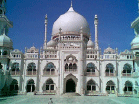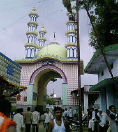With the recent addition of nine, we have 99 cities listed ‘Smart.’ The diversities in the economic conditions of these cities are pronounced.
For analysing the economic background of the selected cities, an important indicator is the availability of banking facilities. Based on the limited data available for some of the cities, here is a quick assessment.
1. Moradabad
Population: 889,810
Bank branches: 141
Credit to deposit ratio: 0.54
A major producer of brassware items, Moradabad is called Pital Nagri. It is the first city in India to foster a gramin bank. Prathama Bank, sponsored by Syndicate Bank, was set up here in 1975.
2. Bareilly

Bank branches: 175
Credit to deposit ratio: 0.42
Bareilly in Uttar Pradesh, the biggest among the nine, is called Zari Nagri and is famous for zari work. Located on the banks of the Ramganga river. It is a major hub for furniture manufacturing. The place is a trading centre in cotton, grain and sugar.
3. Erode

Bank branches: 84
Credit to deposit ratio: 1.27
The Turmeric City, as Erode is called, has one of largest markets for coconut and coconut oil in south India. A leather processing major, it also is the home to a large paper and sugar mills. The Turmeric City, as Erode is called, has one of largest markets for coconut and coconut oil in south India. A leather processing major, it also is the home to a large paper and sugar mills.
4. Saharanpur

Bank branches: 100
Credit to deposit ratio: 0.41
Saharanpur is internationally famous for wooden handicraft work. It has the unique travel facility of the luxurious Scania buses costing Rs.1.23 crore each.
5. Biharsharif

Bank branches: 39
Credit to deposit ratio: 0.24
This district headquarters of Nalanda is a hub of education and trade in south Bihar. The economy centres around agriculture and also tourism and household manufacture.
6. Itanagar

Bank branches: 29
Credit to deposit ratio: 0.32
Banking sector has not grown big in Itanagar.
7. SilvaSsa

Bank branches: 36
Credit to deposit ratio: 0.42
Silvassa is the capital of Dadra and Nagar Haveli. The city has a large number of factories and industries providing significant government revenue, which allows the city to maintain a low level of taxation.
8. Diu

Bank branches: 11
Credit to deposit ratio: 0.025
With no tall buildings except the fort, Diu has a characteristically low skyline. Old Diu is known for its Portuguese architecture.
9. Kavaratti
Credit to deposit ratio: 0.078 (of the UT)
As against these cities, Kavaratti has many limitations because of its geographical conditions.
Kavaratti’s peculiar features
This small island town, part of the Lakshadweep group of islands, located in the Arabian Sea, was long dependent on barter trade with the mainland. Its economy witnessed the development of communication, shipping facilities, electrification and modernisation of fishing after the 1970s. Syndicate Bank was the first bank to open its branch in 1971. Over the years other banks, State Bank of India, UCO Bank and Yes Bank Ltd have stepped into this sleepy town.
One of the major problems faced by banks is the feeble credit absorption capacity of the local economy. The entire Union Territory has been declared as the ‘no industry district’ because of its fragile ecology. Private enterprise is almost non-existent. The selection of Kavaratti for grooming it as a smart city is laudable, as it enables the remote island town to become a unique city in the economic map of the country. However, the investment programmes under the project have to be realistically formulated, extending the planning period beyond five years.


